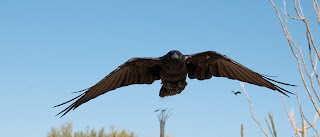Free Flight
We've enjoyed visits to the Tucson area over the past several years during different times of the year. Besides being a birder's mecca, the area boasts the Arizona-Sonora Desert Museum, an excellent introduction to desert habitats. The museum hosts a walk-in aviary, a walk-in hummingbird aviary, and hiking trails through numerous plant and animal exhibits which display desert flora and fauna. The museum also houses the Center for the Sonoran Desert Studies which conducts the museum's educational and scientific functions and which serves as a hub for research, education and conservation of the Sonoran Desert Region.
When we were in Tucson this past May we were joined by friends Dave and Betty Dunsmore (their first ever birding trip to southeastern Arizona). At that time Carol and I became annual members of the museum which scored us guest passes which we were able to share with Dave and Betty.
Now, on our way back from California, we again found ourselves in the Tucson area. And being parked at an RV resort a mere 15-minute drive from the museum, we'd be crazy not to visit as often as possible!
Having visited the museum at various seasons of the year we've come to realize that no matter how many times we visit, there's always something new to see and learn. It just so happened that on the weekend of October 14,15,16, the museum was holding it's annual "Festival of Flight". This year the festival had been expanded to include bats and butterflies with the name expanded to include "Wings over the Desert".
Often times during the year the museum holds special 'members only' events. Kicking off the festival this year was a day early members only behind the scenes preview of the "Raptor Free Flight" program.
The 'free flight' program displays various captive birds that the museum has acquired over the years. The birds are rehabilitated species that no longer can survive in the wild but have been trained to 'fly free' in close proximity to people in order to more closely observe and learn about each species.
 |
| Ferruginous Hawk |
Along with approximately sixty other members we gathered in a section of the Desert Loop Trail set aside for the event. Museum volunteers and staff presented birds one at a time along with detailed explanations about a bird's background, biology and what differentiated it from other birds when it came to hunting for food in the desert. Narrations included specific facts about each bird along with explanations of the different visual cues birds give off before, during and after a flight.
 |
| Prairie Falcon |
While we've seen all the birds displayed in the wild, how exciting it was to be so close and have the time to observe rather than hope for a glimpse before the birds vanished from view!
 |
| Gray Hawk |
The birds do not 'fly free' all year and spend a great deal of time in display enclosures, or, might be on view at various learning stations scattered around the museum grounds at various times of the year. The 'fly free' programs are typically done in the fall when desert temperatures are cooler. Like most life in the desert, most feeding/hunting activities take place at dawn or just around sunset. This is particularly true for nocturnal hunters like Great Horned Owls.
 |
| Great Horned Owl |
While visits to the museum are always interesting, we don't have to travel far for birds. Our RV at Justin's Diamond J RV Park is backed up to 40,000 acres of public land. All we have to do is put out bird seed and water and they come to us!
 |
| Cactus Wren |
 |
| Curve-billed Thrasher |
 |
| Gambel's Quail |
 |
| Gila Woodpecker |
|
 |
| Chihuahuan Raven |
|
 |
| Bobcat |
 |
| Dragonfly |
 |
| Desert Pack Rat |
 |
| Sonoran King Snake |
 |
| Thick-billed Parrot |






























Very cool! The Owl in flight is still my favorite shot.. Love the Tucson area & the Desert Museum .. great post!
ReplyDelete